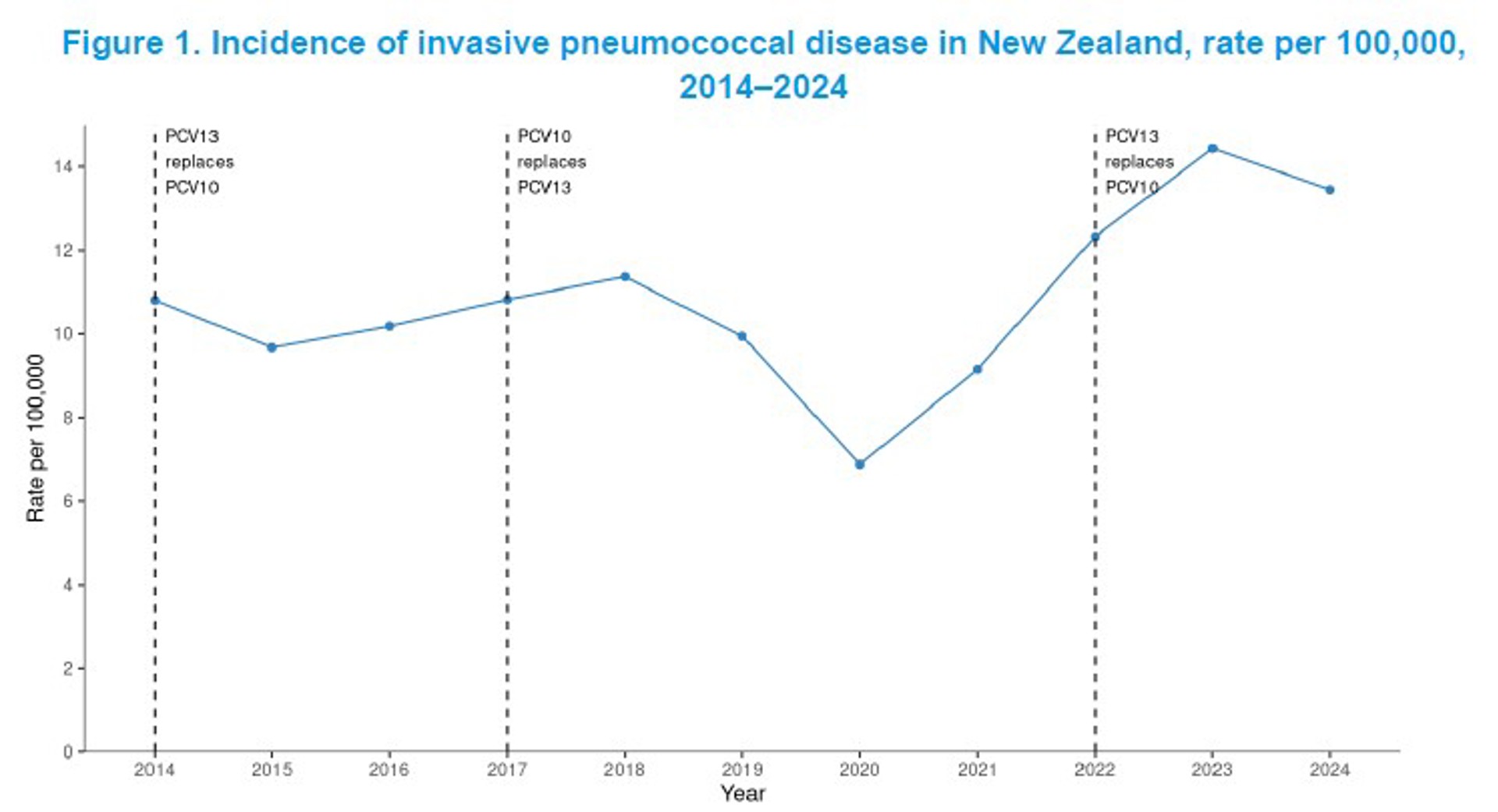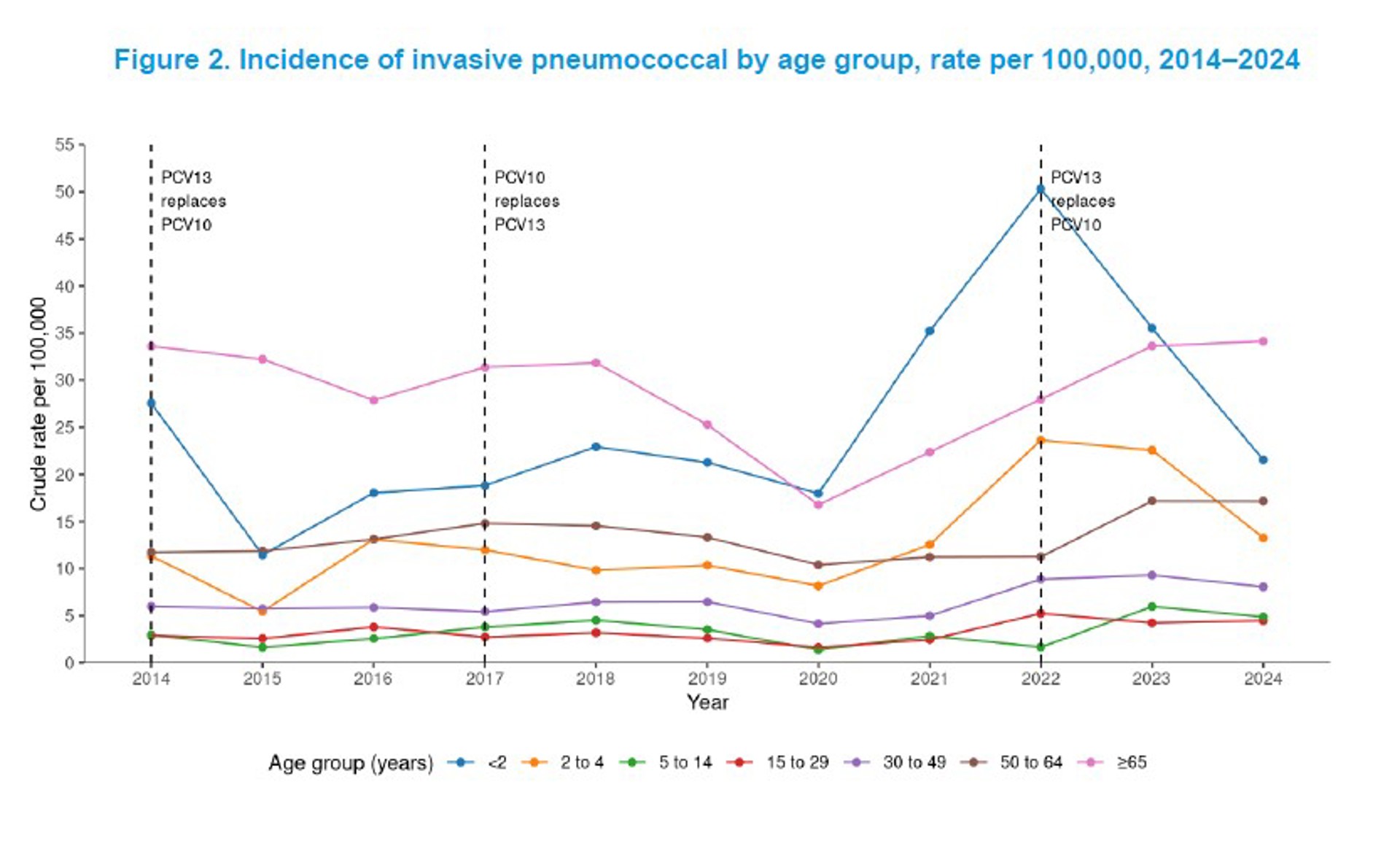ESR has published a report describing the epidemiology of invasive pneumococcal disease (IPD) in New Zealand in 2024, showing incidence of this vaccine-preventable disease has decreased from the high levels reached in 2023. The full report is available here.
Invasive pneumococcal disease is a serious bacterial illness caused by Streptococcus pneumoniae. Different serotypes of the bacterium cause disease and there are vaccines available that provide protection against many of these. A pneumococcal conjugate vaccine (PCV) has been part of the New Zealand childhood immunisation schedule since 2008. It directly protects vaccinated children from disease and also works to reduce carriage of S pneumoniae, which helps to reduce disease in other age groups (this is known as indirect protection).
ESR and the Ministry of Health have closely monitored IPD trends since the first PCV vaccine was introduced in 2008. The vaccine type and schedule has changed several times since 2008.
In response to a rapidly increasing trend in IPD rates in 2021-22, particularly in young children and mostly due to a particular serotype (19A), PCV13 replaced PCV10 on the childhood vaccination schedule in December 2022. This vaccine provides good protection against 13 S. pneumoniae serotypes, including 19A.
Overall, in 2024, there were 718 cases of IPD notified in New Zealand (13.5 cases per 100,000) compared with 757 cases in 2023 (14.5 per 100,000). This is the first year IPD incidence has decreased since 2020, though the overall incidence remains very high compared with 2014-2022. IPD incidence in children <5 years has decreased significantly since 2022, whereas incidence in older adults remains high.

Incidence of IPD in children <2 years has more than halved in 2024 from the peak in 2022. The re-introduction of PCV13 to the childhood immunisation schedule has successfully reduced IPD incidence and specifically incidence of disease due to 19A back to levels seen in 2020, prior to the increase driven by serotype 19A that prompted the vaccine change. In 2024, there were no cases of IPD due to 19A in children <2 years who had received three doses of PCV13.

In addition, despite there being no catch-up campaign to deliver PCV13 to children who had already completed the childhood PCV schedule at the time of the re-introduction, IPD incidence in 2–4-year-olds has also nearly halved in 2024 compared to 2022. This is largely a result of indirect protection in this age group due to reduced carriage among younger children who received PCV13. We expect to see further reductions in IPD incidence in children over the coming years as the cohort of children receiving PCV13 increases.
IPD incidence among older adults aged 50–64 years and ≥65 years reached the highest level in a decade in 2023, and incidence remains high in 2024. A large proportion of disease in these age groups was due to serotype 19A (covered by PCV13). As carriage of 19A reduces in children who received PCV13 as part of the childhood schedule, incidence of disease due to these serotypes is expected to decline in older age groups. International experience suggests it typically takes 3 to 4 years after introduction of PCV13 for this indirect protection to substantially reduce incidence in non-vaccine-eligible age groups.
Despite the overall reduction in IPD incidence among children, there remain significant ethnic disparities. Incidence of IPD among Māori and Pacific children <2 years is consistently much higher than for non-Māori, non-Pacific children. IPD incidence is higher for Pacific peoples and Māori than European/Other and Asian ethnic groups at all ages, and for Pacific peoples, incidence is higher at all levels of deprivation than for other groups. Achieving equitable immunisation coverage is an important priority to further reduce the incidence of IPD and the inequities in IPD incidence in New Zealand.
IPD surveillance is undertaken by ESR under contract to the Ministry of Health and relies on data provided by public health service staff and isolates referred to ESR by diagnostic laboratories in New Zealand. Further information on IPD is also regularly provided on the ESR IPD dashboard.

